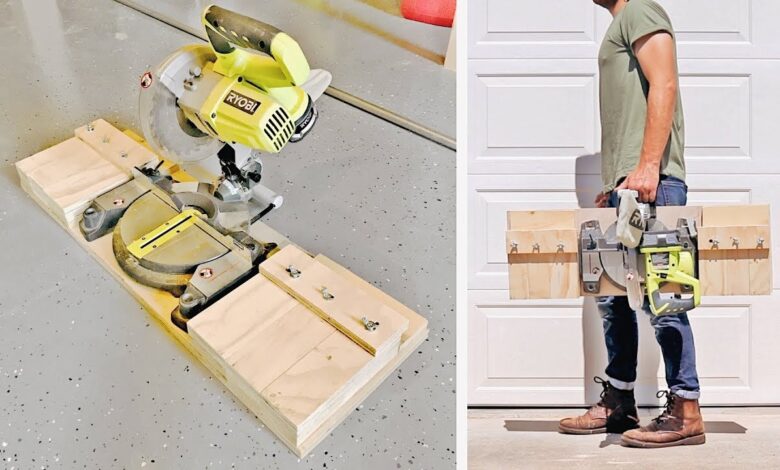
Introduction to DIY Miter Saw Stands
A miter saw is one of the most versatile tools in any woodworking setup, but its functionality truly shines when paired with a sturdy and well-designed stand. A DIY miter saw stand isn’t just a cost-effective alternative to store-bought options; it’s also a customizable solution that caters to your specific needs. Whether you’re crafting in a small garage or a spacious workshop, building your stand lets you optimize your workspace for efficiency and comfort.
At its core, a DIY miter saw stand is about practicality. It provides a stable base for precise cuts and often includes storage or additional features that enhance its usability. But beyond functionality, it’s a rewarding project that allows you to combine creativity with craftsmanship.
Benefits of Building Your Own Miter Saw Stand
Building a miter saw stand on your offers a level of personalization that off-the-shelf options can’t match. When you design and build the stand, you can tailor it to your specific workflow, preferences, and available space.
One of the biggest advantages is cost savings. Commercial miter saw stands can be pricey, especially when looking at high-quality models. With a DIY approach, you can achieve professional-grade results without breaking the bank. You also get to choose the materials, ensuring that your stand is both durable and aligned with your aesthetic preferences.
Another benefit is the satisfaction that comes from creating something with your own hands. Every time you use your DIY miter saw stand, you’ll be reminded of the time, effort, and skill that went into its construction. This connection often enhances the joy of woodworking and fosters a deeper appreciation for the craft.
Materials and Tools for a DIY Miter Saw Stand
When it comes to materials, the beauty of a DIY miter saw stand is its flexibility. Common materials include plywood, hardwood, or even repurposed wood from old furniture or pallets. Plywood is especially popular because it’s affordable, sturdy, and easy to work with.
For the frame, materials like 2x4s or metal pipes provide robust support. If you’re looking to add shelves or storage compartments, MDF or thinner plywood sheets work well. Hardware like screws, hinges, and brackets will be essential for assembly, and wheels can be added if portability is a priority.
As for tools, a miter saw is an obvious requirement, but you’ll also need a drill, screwdriver, measuring tape, and clamps. A level is crucial for ensuring your stand is perfectly aligned, and a sander or sandpaper will help smooth out rough edges. If you’re going for a polished look, consider having paint or wood stain on hand.
Designing the Perfect Miter Saw Stand
Designing your DIY miter saw stand is arguably the most important step. This is where you’ll decide on dimensions, features, and layout. Start by considering how much space you have in your workshop or garage. The stand should fit comfortably without feeling cramped, and it should be at a height that allows for ergonomic use of the saw.
Another crucial aspect is functionality. If you often work with long pieces of wood, incorporating extension arms or supports on either side of the stand will make your tasks much easier. Storage is another consideration; adding drawers, shelves, or hooks can help keep your tools and materials organized.
Portability might also factor into your design. If you frequently move your miter saw between locations, adding wheels or a folding mechanism can be a game-changer. On the other hand, if you prefer a stationary setup, you can prioritize stability and durability over mobility.
Step-by-Step Guide to Building a DIY Miter Saw Stand
The process of building a miter saw stand begins with gathering your materials and tools, followed by measuring and cutting the wood. Accuracy is critical during this stage to ensure that all pieces fit together seamlessly.
Assembling the frame is typically the next step. This involves attaching the legs to the base and ensuring everything is level and secure. Depending on your design, you may add braces or cross supports for extra stability. Once the frame is complete, you can mount the tabletop where the miter saw will sit.
Adding additional features like storage, extension arms, or a dust collection system comes next. These elements often require precision and creativity, so take your time to ensure they’re both functional and aesthetically pleasing. Finally, sand down any rough edges and apply a finish to protect the wood and enhance its appearance.
Safety Considerations for DIY Miter Saw Stands
Safety is a critical aspect of woodworking, and building a miter saw stand is no exception. Always wear protective gear, including safety goggles and gloves, to prevent injuries. When using power tools like drills and saws, follow the manufacturer’s instructions and work slowly to avoid accidents.
Ensuring that your miter saw stand is stable and level is another key safety consideration. A wobbly stand can lead to inaccurate cuts and potential hazards. If your design includes wheels, make sure they can lock in place to keep the stand stationary during use.
Finally, consider incorporating safety features into the design of your stand. For instance, adding a secure mount for the saw or a designated space for tools can prevent accidents and keep your workspace organized.
Customization Ideas for Your DIY Miter Saw Stand
One of the best parts about building your miter saw stand is the opportunity for customization. Adding features like foldable wings or extension arms can make your stand more versatile, allowing you to handle longer pieces of wood with ease.
Incorporating storage is another popular customization. Shelves, drawers, and pegboards can keep your tools and materials within easy reach, making your workspace more efficient. If you frequently work with different saws, consider designing a modular stand that can accommodate multiple tools.
For those who value aesthetics, painting or staining your stand can give it a polished, professional look. You can even match the finish to the rest of your workshop furniture for a cohesive design.
Maintaining Your DIY Miter Saw Stand
Proper maintenance ensures that your miter saw stand remains in top condition for years to come. Regularly check for loose screws or bolts, and tighten them as needed. If your stand is made of wood, inspect it for signs of wear or damage and address any issues promptly.
Cleaning is another important aspect of maintenance. Sawdust and debris can accumulate over time, affecting the functionality of your stand. Use a vacuum or brush to keep the surfaces clean, and consider applying a protective finish periodically to prevent wear and tear.
If your stand includes moving parts like wheels or hinges, lubricate them occasionally to keep them functioning smoothly. This proactive approach will not only extend the lifespan of your stand but also enhance its performance.
The Joy of DIY Projects
Building a miter saw stand is more than just a practical endeavor; it’s a chance to embrace the spirit of DIY craftsmanship. The process of designing, building, and customizing your stand allows you to flex your creative muscles and develop new skills.
There’s a unique satisfaction in using something you’ve built with your own hands. Every time you fire up your miter saw, you’ll be reminded of the time and effort you invested in creating a stand that perfectly suits your needs. This connection often deepens your appreciation for both the tool and the craft.
Conclusion
A DIY miter saw stand is the ultimate combination of functionality and creativity. By building your stand, you gain a customizable, cost-effective solution that enhances your woodworking experience. From the initial design to the final touches, the process is as rewarding as the result.




